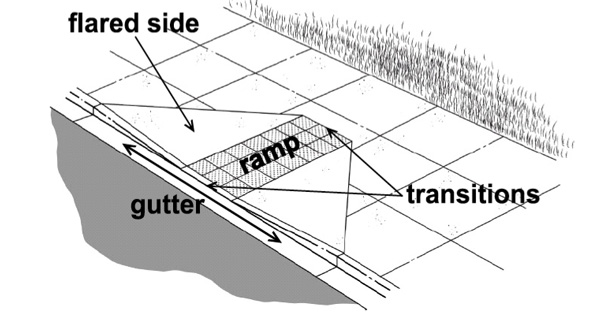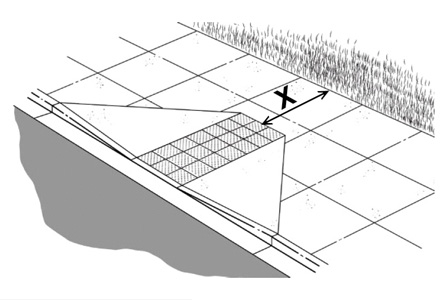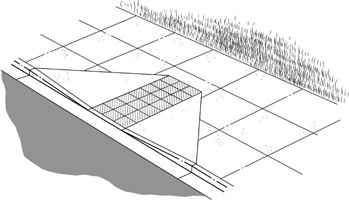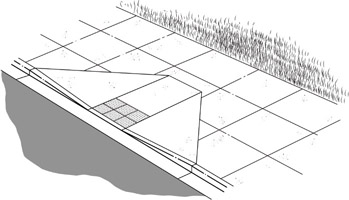
NOTICE
Portions of this chapter may not fully reflect the current ADA regulations. The regulation implementing title II of the ADA was revised as recently as 2016. Revised ADA Standards for Accessible Design (2010 Standards) were issued on September 15, 2010 and went into effect on March 15, 2012.
Additional related information can be found in the Department of Justice/Department of Transportation joint 2013 publication and 2015 publication.
ADA Best Practices Tool Kit for State and Local Governments
The process of adopting revised federal accessibility standards for public rights-of-way may be lengthy. In the meantime, many state and local governments will construct and alter highways, streets, roads, sidewalks, and pedestrian crossings. This Chapter is an effort to ensure that public entities do not create barriers to access by omitting curb ramps while the broader debate on accessibility requirements for public rights-of-way moves forward
B. What Is a Curb Ramp?
A curb ramp is a short ramp cutting through a curb or built up to it. 1 If designed and constructed to be accessible, a curb ramp provides an accessible route that people with disabilities can use to safely transition from a roadway to a curbed sidewalk and vice versa.
The different parts of the most common type of curb ramp, a perpendicular curb ramp, are labeled in the illustration below. The ramp, or ramp run, is the sloped section that individuals who use wheelchairs travel up and down when transitioning between the street and the sidewalk. Transitions between the ramp and the sidewalk, gutter and street are located at the top and bottom of the ramp run. Flared sides, or flares, bring the curb itself to the level of the street. The gutter is the roadway surface immediately next to the curb ramp that runs along the curb.

1 28 C.F.R. Part 36, Appendix A, § 3.4. Some people refer to curb ramps as “curb cuts" because most curb ramps cut through the curb.
C. Why are Curb Ramps at Pedestrian Crossings Required?
It is often difficult or impossible for a person using a wheelchair, scooter, walker, or other mobility device to cross a street if the sidewalk on either side of the street ends without a curb ramp. It is also dangerous. If curb ramps are not provided, these individuals are forced to make a difficult choice. They can either stay at home and not go to their chosen destination, or they can risk their personal safety by using their wheelchairs, scooters, or walkers to travel alongside cars and other vehicles in the streets. This is a choice that people with disabilities should not be required to make.
D. What Does Title II of the ADA Require with Respect to Curb Ramps at Pedestrian Crossings?
Title II of the ADA requires state and local governments to make pedestrian crossings accessible to people with disabilities by providing curb ramps. 2 This requirement applies if your state or local government has responsibility or authority over highways, streets, roads, pedestrian crossings, or walkways. Some public entities have extensive responsibility for the highways, streets, roads, pedestrian crossings, and walkways in their area, but most public entities have at least limited responsibility for them.
To allow people with disabilities to cross streets safely, state and local governments must provide curb ramps at pedestrian crossings and at public transportation stops where walkways intersect a curb. To comply with ADA requirements, the curb ramps provided must meet specific standards for width, slope, cross slope, placement, and other features. 3 In constructing facilities such as walkways and pedestrian crossings, state and local governments can choose between two sets of standards – the ADA Standards for Accessible Design (ADA Standards) and the Uniform Federal Accessibility Standards (UFAS). 4 Both of these standards have been deemed to comply with the requirements of Title II. 5 However, state and local governments cannot pick and choose between particular portions of the ADA Standards and UFAS as they construct or alter the pedestrian crossings on a street and the curb ramps that provide access to the adjacent sidewalks. Only one of these two standards may be used for a particular facility. In the construction or alteration of roadways and walkways, this typically means that only one standard may be used for a particular construction or alteration project, and all features of that project typically must comply with the chosen standard. Departures from particular requirements of either standard by the use of other methods are permitted when it is clearly evident that equivalent access is provided. 6
2 28 C.F.R. §§ 35.150(d)(2), 35.151(2 (e).
3 28 C.F.R. Part 36, Appendix A, § 4.7; 41 C.F.R. Part 101 - 19.6, Appendix A, § 4.7.
4 The ADA Standards are located at 28 C.F.R. Part 36, Appendix A. They are also available on the ADA Home Page at archive.ada.gov. UFAS is located at 41 C.F.R. Part 101 - 19.6, Appendix A, and at the Access Board's website at www.access-board.gov/ufas/ufas-html/ufas.htm.
5 28 C.F.R. § 35.151(c).
6 28 C.F.R. § 35.151 (c).
E. What are the General Requirements for Curb Ramps in the ADA Standards for Accessible Design?
One way to make curb ramps compliant with Title II of the ADA is to build them in accordance with the ADA Standards. 7 Following are the key characteristics of an accessible curb ramp according to the ADA Standards:
The rise is the vertical change measured from the low point at the base of the curb ramp to the high point at the other end where the sloped portion of the curb ramp transitions with the sidewalk. Since sidewalks often have a 2 percent or less cross slope (which is the slope perpendicular to the direction of pedestrian travel along the sidewalk) to direct water toward the street for drainage, the rise of a curb ramp is often greater than the height of the curb.
Perpendicular Curb Ramps in the ADA Standards: Flared Sides or Returned Curbs?

The most common type of curb ramp is the perpendicular curb ramp, which intersects the curb at a 90-degree angle. Curb ramps must have flared sides if people are required to walk across them. [§ 4.7.5] The slope requirements for the flared sides depend on the width of the sidewalk at the top of the ramp, “x” in the illustration to the right. If “x” is less than 48 inches, then the slope of the flared sides must be no more than 8.33 percent (1:12). If “x” is 48 inches or more, then the flared sides may slope up to 10 percent (1:10) but not more. [§ 4.7.5; Fig. 12(a)]
F. What are Pedestrian Crossings and Where Must Curb Ramps be Provided?
Where and when curb ramps are required depends on the location and the age of streets and sidewalks.
1. Location
Generally, you must provide curb ramps wherever a sidewalk or other pedestrian walkway crosses a curb. Curb ramps must be placed to enable a person with a mobility disability to travel from a sidewalk on one side of the street, over or through any curbs or traffic islands, to the sidewalk on the other side of the street. Remember, walkways include areas where people must walk to access bus stops and other public transportation stops, so, where necessary, curb ramps must also be provided to enable people with disabilities to board and exit public transportation.
2. Age of Streets and Sidewalks
In addition, the requirements vary depending on the age of a highway, road, street, or sidewalk, and depending on when and whether it was paved, repaved, resurfaced beyond normal maintenance, or otherwise altered.
“Pre-ADA” streets, sidewalks, roads, and highways are those that were built before January 26, 1992, and have not since been altered.
“Alterations” are another category of construction under the ADA. A street or sidewalk falls into this category if it was constructed pre-ADA (construction began before January 26, 1992), and has since been altered. What does “altered” mean? An alteration is a change that affects usability. Resurfacing a roadway beyond normal maintenance is an alteration. By contrast, filling potholes is not. 8
For purposes of the ADA, any street or sidewalk is “new” or “post-ADA” if its construction commenced after January 26, 1992. 9
7 The bracketed references in this section refer to the applicable sections of the ADA Standards
8 28 C.F.R. § 35.151(b).
9 28 C.F.R. § 35.151(a).
3. New Construction vs. Alterations
The requirements in the ADA Standards for curb ramps newly constructed post-ADA (construction commenced after January 26, 1992) can be found in § 4.7. The requirements for curb ramps that have been altered post-ADA are the same, except for in the following cases.
When pre-ADA streets or sidewalks are altered, there may be space limitations that restrict how much they can be altered to install accessible curb ramps. In these cases, the curb ramps installed must meet the accessibility requirements of the ADA to the maximum extent feasible. 10 Scoping requirements in the ADA Standards establish limitations for the running slope of the ramp run of curb ramps installed during alterations to pre-ADA streets and walkways. 11
The Civil Rights Division recognizes that there will be very rare instances when it will be technically infeasible for a curb ramp installed during alterations to pre-ADA roadways and walkways to be constructed in full and strict compliance with the requirements of ADA Standards § 4.1.6(3)(a) and § 4.7 because of physical or site constraints. In such circumstances, state and local governments must install curb ramps that provide accessibility to the maximum extent feasible. 12 Before reaching a conclusion about technical infeasibility, state and local governments need to consider the extent to which physical or site constraints can be addressed by alternative curb ramp designs. The burden of proving technical infeasibility lies with the state or local government that constructed it.
Alternative Curb Ramp Designs
A parallel curb ramp consists of two ramps joined in the middle by a landing that is level with the roadway. Parallel curb ramps run parallel to the curb and usually take up the whole width of the sidewalk.
Combined curb ramps are a combination of the perpendicular and parallel curb ramp designs. The combined curb ramp breaks the elevation change between the curb and the street into two parts, and uses a separate ramp to bridge each part: a parallel ramp from the sidewalk to a level landing, and a perpendicular ramp from the level landing to the roadway.
10 28 C.F.R. § 35.151(b).
11 ADA Standards § 4.1.6(3)(a).
12 ADA Standards § 4.1.6(1)(j).
When highways, streets, and roads are built or altered post-ADA, they must have curb ramps at certain locations. Curb ramps must be located wherever there are curbs or other barriers to entry from a pedestrian walkway or sidewalk, including any intersection where it is legal for a pedestrian to cross the street, whether or not there is any designated crosswalk. Curb ramps must also be located wherever there are curbs or other barriers to entry at any designated pedestrian crosswalks that are located mid-block. Likewise, when sidewalks or walkways are built or altered post-ADA, they must include curb ramps or other sloped areas wherever they intersect with highways, streets, or roads and pedestrians may legally cross the vehicular way as well as at public transportation stops.
By contrast, for pre-ADA highways, streets, roads, and sidewalks that have not been altered, state and local governments may choose to construct curb ramps at every point where a pedestrian walkway intersects a curb. However, they are not necessarily required to do so. Under a more flexible standard called “program access,” alternative routes to buildings may be acceptable where people with disabilities must travel only a marginally longer route than the general public.
4. Example: Installing Curb Ramps for Program Accessibility
Consider a case where the streets and sidewalks in a small town were built pre-ADA and have not been altered since. Some intersections have curb ramps; most do not. The town is trying to figure out where to install curb ramps to provide access to the town hall. The accessible entrance to the town hall is located on North Street, which is on the north side of the building. The parking garage that serves the town hall is located on North Street, directly across the street from the town hall’s accessible entrance. Public transportation stops serving the town hall are in a residential neighborhood on East Street, two blocks east of the town hall. The town is evaluating where it needs to install curb ramps to comply with Title II requirements.
Since the town hall and its surrounding streets and sidewalks were built pre-ADA and have not since been altered, the town must install curb ramps in compliance with Title II’s program access requirements for pre-ADA facilities. Under these requirements, the town may choose to install curb ramps at all pedestrian crossings on the sidewalks surrounding the town hall, but it is not necessarily required to do so. A program access approach would require the town to install curb ramps at key pedestrian crossings. To provide access to the town hall, curb ramps would need to be installed at the pedestrian crossings and transportation stops along North and East streets so people with disabilities can travel along a pedestrian route between (1) the accessible entrance to the town hall and the accessible entrance to the parking garage and (2) the accessible entrance to the town hall and the public transportation stops on East Street. In this instance, installing curb ramps at the pedestrian crossings on the south side of the townhall are not needed from a program access perspective to enable people with disabilities to access the town hall. However, they may be needed from a program access perspective for other reasons, such as providing access to other town facilities served by the parking garage or to the town’s business district. The town should seek input from people with mobility disabilities regarding the other key locations where curb ramps need to be installed to provide program access.
G. What are Detectable Warnings, Why are They Required, and Where Must They be Provided?
The ADA Standards require that curb ramps include features called “detectable warnings.” Detectable warnings consist of a series of small domes that contrast in color with the surrounding sidewalk or street. They must be integrated into the walking surface, and there are specific measurements for the size and spacing of the domes. 13
What is the function of detectable warnings? Detectable warnings are intended to function much like stop signs for pedestrians who are blind or have low vision. The warnings, which are intended to be felt with pedestrians’ feet, alert blind individuals and those with low vision that they are about to enter a street or other area where cars pass. A detectable warning alerts pedestrians who are blind or have low vision that they need to stop and determine the nature of the hazard – such as whether there is passing traffic – before continuing on their way.

Under the ADA Standards, curb ramps are required to have detectable warnings that extend the full width and depth of the curb ramp. 14 An example of a perpendicular curb ramp that complies with this requirement can be seen to the left.

The U.S. Department of Transportation (DOT), however, is encouraging the use of a different design for detectable warnings. 15 Under this design, detectable warnings extend the whole width of the ramp, but cover only the two feet of the ramp closest to the street. DOT has deemed this departure from the ADA Standards to be permitted under Title II of the ADA. 16 An example of a curb ramp that complies with the DOT’s design can be seen on the right.
H. How Can You Tell if a Curb Ramp is Accessible?
The best way to determine if a curb ramp is accessible is to survey it to determine the extent to which it complies with ADA accessibility requirements. To assist you, the next installment of this Tool Kit will include instructions on how to survey curb ramps for compliance with the ADA Standards and a Curb Ramps survey form for use in conducting your surveys. The instructions, which will be located in Appendix 1, are keyed to the Curb Ramps survey form, which will be located in Appendix 2, and will provide an explanation of how to obtain the information needed to answer each question on the survey form. The instructions will also include photographs and illustrations showing how and where to take measurements. The Curb Ramps survey form and instructions will help you identify the most common accessibility problems with curb ramps, but they will not necessarily identify all problems.
13 ADA Standards § 4.29.2.
14 ADA Standards § 4.7.7.
15 DOT’s memorandum encouraging use of this alternate design for detectable warnings is available on its website at www.fhwa.dot.gov/environment/bikeped/dwm.htm.
16 28 C.F.R. § 35.151(c)
I. Ensuring Compliance Now and In the Future